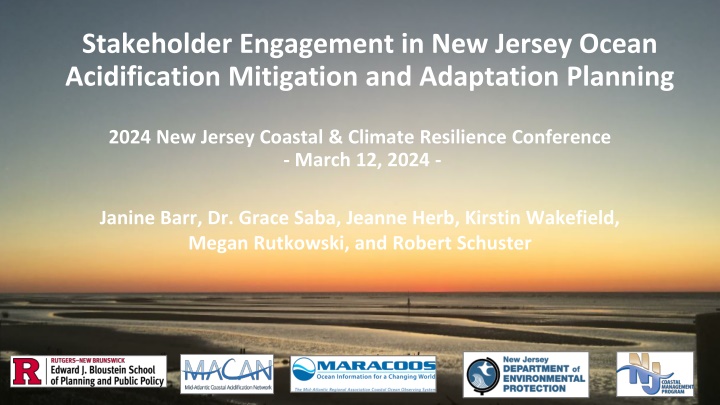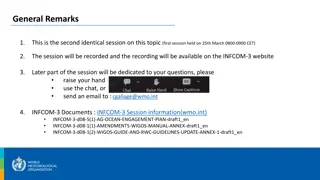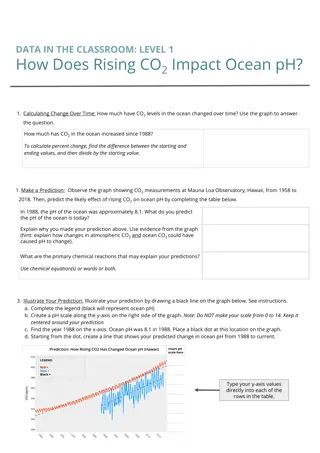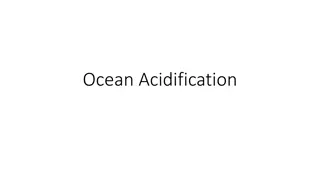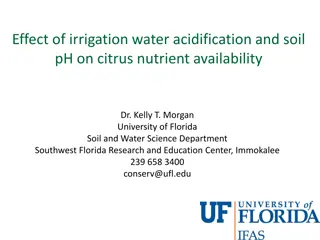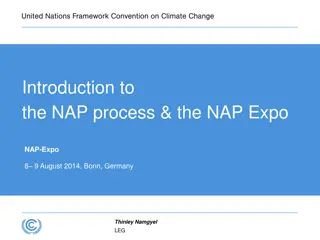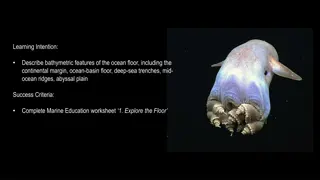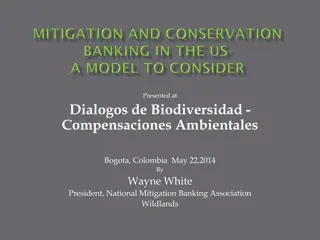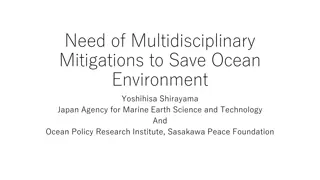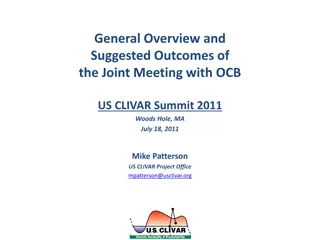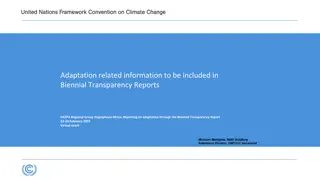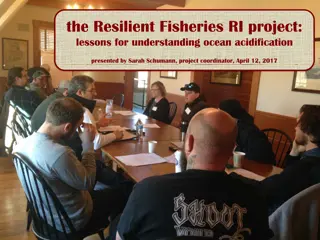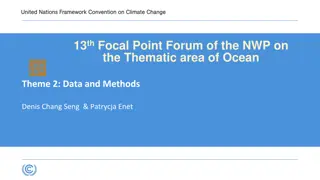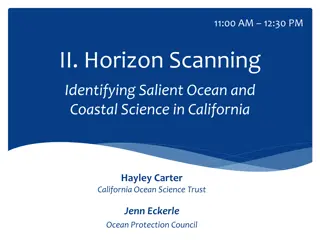Stakeholder Engagement in New Jersey Ocean Acidification Mitigation and Adaptation Planning
This content discusses stakeholder engagement in New Jersey's efforts to mitigate and adapt to ocean acidification, focusing on the economic, social, and environmental impacts on coastal communities. The process, methods, goals, and key takeaways of stakeholder engagement are outlined, emphasizing the importance of including various stakeholders in developing a statewide action plan. The project team's experience and the identification of stakeholders from different sectors are also highlighted.
Download Presentation

Please find below an Image/Link to download the presentation.
The content on the website is provided AS IS for your information and personal use only. It may not be sold, licensed, or shared on other websites without obtaining consent from the author.If you encounter any issues during the download, it is possible that the publisher has removed the file from their server.
You are allowed to download the files provided on this website for personal or commercial use, subject to the condition that they are used lawfully. All files are the property of their respective owners.
The content on the website is provided AS IS for your information and personal use only. It may not be sold, licensed, or shared on other websites without obtaining consent from the author.
E N D
Presentation Transcript
Stakeholder Engagement in New Jersey Ocean Acidification Mitigation and Adaptation Planning 2024 New Jersey Coastal & Climate Resilience Conference - March 12, 2024 - Janine Barr, Dr. Grace Saba, Jeanne Herb, Kirstin Wakefield, Megan Rutkowski, and Robert Schuster
Overview Driver of Stakeholder Engagement Process Stakeholder Engagement Methods Key Takeaways Takeaways Engagement Methods Introduction
Many coastal communities have commercial and recreational use of local waters incorporated in their economies and cultures at the foundational level. If OA depresses or drives the collapse of fisheries and negatively impacts environmental conditions to the point that it affects social and recreational activities (water quality, fish kills, human health, etc.), it could drastically re-write the state's economy, culture, and charm. -New Jersey OA Stakeholder, 2023
Mills NJ.com Economic and social connection to New Jersey coastal waters 2021 New Jersey Climate Change Resilience Strategy 2023 Stakeholder Engagement Process Downbeach Buzz
Stakeholder Engagement Overview Stakeholder Engagement Goals Learn stakeholder concerns and priorities regarding the threat of OA Use stakeholder input to inform elements and content of a statewide OA Action Plan Three Elements of Success Project team with range of expertise was crucial Including decision makers in the stakeholder engagement process was beneficial Engaging with stakeholders formally multiple times was helpful Takeaways Engagement Methods Introduction
Project Team Experience Regulatory and policy oNew Jersey Department of Environmental Protection Monitoring and science oRutgers University oMid-Atlantic Coastal Acidification Network (MACAN) oMid-Atlantic Regional Association Coastal Ocean Observing System (MARACOOS) Stakeholder engagement oRutgers University Takeaways Engagement Methods Introduction
Identifying Stakeholders Coastal Advocacy & Restoration Groups Academia Coastal Management & Education Groups Industry Members Secondary Organizations State Federal Government Government
Identifying Stakeholders Coastal Advocacy & Restoration Groups Academia Stakeholders Coastal Management & Education Groups Industry Members Secondary Organizations State Federal Government Decision Makers Government
Engagement Process Readings Workshop 1 oActivity "OA Basics" and background information oHomework Survey on OA concerns and ranking exercise. Workshop 2 oActivity Deep dive discussions oHomework Identify goals to achieve in the next five-years Workshop 3 oActivity Preview of recommendations and opportunity for final thoughts Review of final report Takeaways Engagement Methods Introduction
Overview of Stakeholder Input Fishery-dependent communities are already living with remnant fisheries and want to be part of the solution to OA Enhancing New Jersey s monitoring network and conducting OA research is important and should not preclude taking OA mitigation actions now Establish an OA Workgroup/Coordination Committee to serve as the primary communicator with the NJ Department of Environmental Protection and serve as a consulting body for future OA mitigation and adaptation decisions. Takeaways Engagement Methods Introduction
Reflections on Methods Successful Elements: Daytime and evening sessions Round robin introductions at start of meeting Debriefing at start of each meeting Verbal and written input opportunities Parallel check-ins with State experts (NJ OA Team) Stipend for stakeholders Challenges: Live surveys are difficult unless they are short Time constraints on secondary organizations Takeaways Engagement Methods Introduction
Janine Barr janine.barr@rutgers.edu Rutgers University Bloustein School of Planning and Public Policy Environmental Analysis and Communications Group
